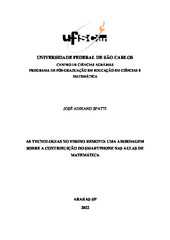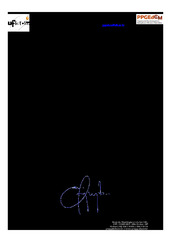| dc.contributor.author | Spatti, José Adriano | |
| dc.date.accessioned | 2022-10-17T15:22:44Z | eng |
| dc.date.available | 2022-10-17T15:22:44Z | eng |
| dc.date.issued | 2022-08-29 | eng |
| dc.identifier.citation | SPATTI, José Adriano. As tecnologias no ensino remoto: uma abordagem sobre a contribuição do smartphone nas aulas de matemática. 2022. Dissertação (Mestrado em Educação em Ciências e Matemática) – Universidade Federal de São Carlos, Araras, 2022. Disponível em: https://repositorio.ufscar.br/handle/ufscar/16889. | * |
| dc.identifier.uri | https://repositorio.ufscar.br/handle/ufscar/16889 | por |
| dc.description.abstract | Technology can contribute to the teaching process and is considered a means for learning to occur. Taking into account the pandemic situation that affected the world in 2020, this dissertation presents the result of an exploratory and reflective study whose objective was to identify aspects that implied in the practice of the mathematics teacher in the face of remote teaching - considered by the authorities as a emerging solution to preserve people's health - causing profound changes in the educational scenario through a teaching format unknown until then. To facilitate and assist this confrontation, the use of digital technologies has become indispensable to guarantee the learning of students, especially in Mathematics. This scientific research, whose methodology will be a bibliographic review and content analysis by Bardin, meets this need to reflect on the use of the smartphone as an emerging resource with great access to the general population, contextualizing its use as a resource that facilitates learning, bringing their contributions and also the weak points within the educational process, providing an opportunity to reflect on the importance of diversifying pedagogical practices, which required a new look at education itself. In this sense, it is necessary to include all the actors involved in the study: students, teachers and the school community, so that technological innovation goes beyond the issue of methodological practice, so that cultural and social aspects can also be experienced. The great differential shown, however, will be the increment of new ways of presenting mathematics to students using the smartphone as an innovative resource. The Google Scholar, Scielo and Web of Science platforms were used to survey the works, restricting the temporality between the years 2020 and 2022. The 72 results obtained in the bibliographic survey were categorized through the following aspects: Potentialities, Weaknesses; Content Involved; Intentionality; Applications Used and Results Obtained. There is no way to despise the smartphone. He has already become a partner for work, studies and also for leisure of both subjects involved in the educational process. It is necessary to look at the possibilities of contribution of the device as an enabling tool, in the contribution of learning, from other angles, and it is up to educators to guide students in the conscious use of this technology, which has gone from villain to protagonist in this scenario of remote teaching. | eng |
| dc.description.sponsorship | Não recebi financiamento | por |
| dc.language.iso | por | por |
| dc.publisher | Universidade Federal de São Carlos | por |
| dc.rights | Attribution-NonCommercial-NoDerivs 3.0 Brazil | * |
| dc.rights.uri | http://creativecommons.org/licenses/by-nc-nd/3.0/br/ | * |
| dc.subject | Tecnologia | por |
| dc.subject | Ensino remoto | por |
| dc.subject | Technology | eng |
| dc.subject | Remote Teaching | eng |
| dc.subject | Smartphone | eng |
| dc.title | As tecnologias no ensino remoto: uma abordagem sobre a contribuição do smartphone nas aulas de matemática | por |
| dc.title.alternative | Technologies in remote teaching: an approach on the contribution of smartphone in mathematics classes | eng |
| dc.type | Dissertação | por |
| dc.contributor.advisor1 | Veraszto, Estéfano Vizconde | |
| dc.contributor.advisor1Lattes | http://lattes.cnpq.br/6253673132956358 | por |
| dc.description.resumo | A tecnologia pode contribuir no processo de ensino e é considerada um meio para que ocorra a aprendizagem. Levando em conta a situação de pandemia que acometeu o mundo no ano de 2020, essa dissertação apresenta o resultado de um estudo exploratório e reflexivo cujo objetivo foi identificar aspectos que implicaram na prática do professor de Matemática diante do ensino remoto - tido pelas autoridades como uma solução emergente para preservar a saúde das pessoas - originando profundas mudanças no cenário educacional através de um formato de ensino desconhecidos até então. Para viabilizar e auxiliar esse enfrentamento, o uso das tecnologias digitais tornaram indispensáveis para a garantia da aprendizagem dos educandos, em especial na Matemática. Essa pesquisa científica, cuja metodologia será revisão bibliográfica e análise de conteúdo de Bardin, vem ao encontro dessa necessidade de refletir sobre a utilização do smartphone como um recurso emergente de grande acesso à população em geral, contextualizando a sua utilização como recurso facilitador da aprendizagem, trazendo as suas contribuições e também os pontos frágeis dentro do processo educativo, oportunizando uma reflexão sobre a importância da diversificação das práticas pedagógicas, o que necessitou um novo olhar para a própria educação. Neste sentido, se faz necessário inserir no estudo todos os atores envolvidos: alunos, professores e comunidade escolar, para que a inovação tecnológica ultrapasse a questão da prática metodológica, para que os aspectos culturais e sociais também possam ser vivenciados. O grande diferencial mostrado, no entanto, será a incrementação de novas formas de apresentar a Matemática aos alunos utilizando o smartphone como recurso inovador. Para levantamento das obras foram utilizadas as plataformas Google Acadêmico, Scielo e Web of Science, restringindo a temporalidade entre os anos de 2020 e 2022. Os 72 resultados obtidos no levantamento bibliográfico foram categorizados através dos seguintes aspectos: Potencialidades, Fragilidades; Conteúdo Envolvidos; Intencionalidade; Aplicativos Utilizados e Resultados Obtidos. Não há como desprezar o smartphone. Ele já se tornou um parceiro para trabalho, estudos e também para lazer de ambos sujeitos envolvidos no processo educacional. É preciso olhar por outros ângulos as possibilidades de contribuição do dispositivo como ferramenta possibilitadora, na contribuição da aprendizagem, cabendo aos educadores, guiar os estudantes na utilização consciente desta tecnologia, que passou de vilão a protagonista neste cenário do ensino remoto. | por |
| dc.publisher.initials | UFSCar | por |
| dc.publisher.program | Programa de Pós-Graduação em Educação em Ciências e Matemática - PPGEdCM-Ar | por |
| dc.subject.cnpq | CIENCIAS HUMANAS::EDUCACAO::ENSINO-APRENDIZAGEM | por |
| dc.publisher.address | Câmpus Araras | por |
| dc.contributor.authorlattes | http://lattes.cnpq.br/4360031288004296 | por |


